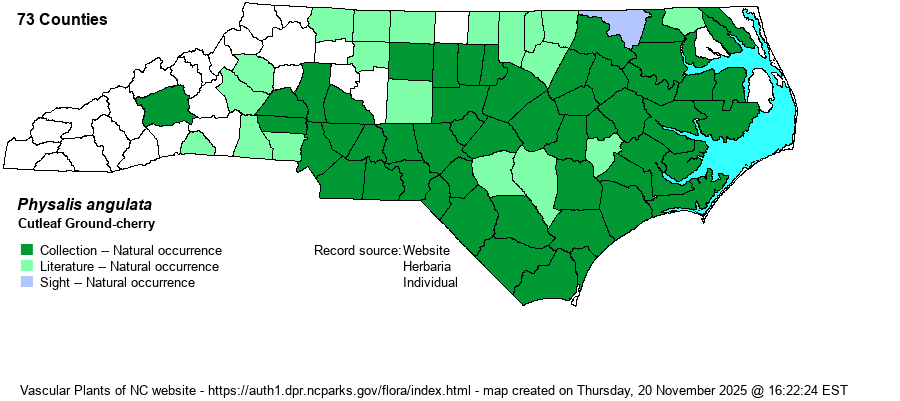| Author | L. | |
| Distribution | Throughout the Coastal Plain, and -- as of 2025 -- now essentially throughout the Piedmont. One Mountain county record. Clearly is rapidly spreading westward, as when RAB (1968) was published, records were only west to the eastern and southern portions of the Piedmont.
Apparently native north to southeastern VA and to KS; ranges south to the Gulf Coast. Some references may suggest that it is adventive to our area, but Weakley (2024) considers it native in NC. | |
| Abundance | Common in most of the Coastal Plain; infrequent to fairly common in the southeastern Piedmont, but rather rare to uncommon but increasing in the western portions and very rare in the mountains. The State Rank is absolutely S5 now. | |
| Habitat | This is a Physalis of mostly disturbed, ruderal habitats, thus giving a reason for its uncertain nativity in our area. It occurs in weedy fields, vacant lots, and roadsides -- usually in somewhat sandy soil. | |
| Phenology | Blooms from August to October, and fruits soon after flowering. | |
| Identification | This is a medium-sized herb growing to about 1.5 feet tall, with some branching. It is generally smooth to somewhat pubescent but is not strongly hispid like many others in the genus. The leaves tend to be opposite, or simply opposite from a branch. Leaves are ovate to elliptic, about 3 inches long and half as wide, with distinctly large teeth with sharp tips. All other NC species have only low teeth or rounded lobes as opposed to large, triangular teeth. The flowers of all Physalis are similar, being mostly single from leaf axils, dangling on curved pedicels, light to medium yellow, facing downward; the shape is somewhat bell-shaped. In this species, the flowers are rather small, about 3/4-inch across. This species can often be seen along the margins of croplands in the Coastal Plain. | |
| Taxonomic Comments | None
| |
| Other Common Name(s) | Smooth Ground-cherry, Wild Gooseberry | |
| State Rank | S4 [S5] | |
| Global Rank | G5 | |
| State Status | | |
| US Status | | |
| USACE-agcp | FACU link |
| USACE-emp | FAC link |

